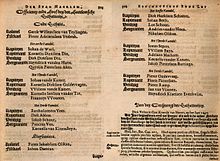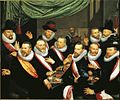Haarlem schutterij

The Haarlem schutterij refers to a collective name for the voluntary civic guard of Haarlem, from medieval times up to the Batavian Revolution in 1794, when the guilds of Haarlem were disbanded.
History

During the
In 1520 the Haarlem schutterij was reorganized; the two groups under St. Joris were merged into one group for crossbowmen and a new group was formed under the patron saint
The most heroic deeds of the Haarlem schutterij occurred during the Spanish
The split into two groups was more for convenience sake than for tradition, as the two groups were split geographically into a group north of the Bavochurch (officially renamed Grote Kerk) and a group south of the Bavochurch.
Cloveniers

The term "Cloveniers", or Cluveniers, just means "musket bearers". The group name changed over time according to the fashions and locations of the guild. Until the siege of Haarlem they were under the patronage of the Saint Adrian, but were most often referred to as the "Jonge schuts", or "New shoots", since they were formed in 1520. After the siege, since all "Catholic" saints were banned, and they had a new meeting hall built in 1612, they became known as the "Nieuwe schuts", or "New shoots". That meeting hall in the Gasthuisstraat is still called the "Doelen" building after them. Today it is a study hall and part of the Haarlem Public Library.[1] The paintings by Hals and others hung in the main hall of the building in the Gasthuisstraat. Today almost all of the schutterstukken that once hung here have been transferred to the Frans Hals Museum; the 1612 painting by Cornelis Engelsz is in the Musée des Beaux-Arts de Strasbourg, France.
Group portraits of the Cloveniers
-
1583, by Cornelis van Haarlem
-
1594, unknown artist
-
1600, by Frans Pietersz de Grebber
-
1610, by Frans Pietersz de Grebber
-
Cornelis Engelsz.
-
1618, by Cornelis Engelsz.
-
1619, by Frans Pietersz de Grebber
-
The Banquet of the Officers of the St Adrian Militia Company in 1627, by Frans Hals
-
The Officers of the St Adrian Militia Company in 1633, by Frans Hals
-
The Officers of the St George Militia Company in 1639, by Frans Hals
-
Ensign Andries Stilte, 1640, by Johannes Cornelisz Verspronck
-
1642, by Pieter Soutman
-
1787, by Wybrand Hendriks
St. Jorisdoelen

In 1577, the city council refurbished the main buildings of the old St. Michiels cloister to house the schutterij called the "Oude schuts", whose hall had been burned in the fire of 1572. Though they officially no longer had a patron saint, they were still referred to as the St. Jorisdoelen, or St. George militia target field. The former garden was converted to include two shooting lanes, and a new meeting hall was built in 1592.[2] Today the location houses a shop, restaurant, and a hofje surrounds the garden called the Proveniershuis.
Group portraits of the St. Jorisdoelen
-
1599, by Cornelis van Haarlem
-
1618, by Frans Pietersz de Grebber
-
1624, by Frans Pietersz de Grebber
-
The Officers of the St George Militia Company in 1639, by Frans Hals
-
1644, by Pieter Soutman
References
- ^ report on Rijksmonument number 19558
- ^ report on Rijksmonument number 19243
- De Stadsdoelen,publication by the Vereniging Haarlem in 1974 on the opening of the new wing of the central library, edited by C. van der Haar and with a preface by J.J. Temminck, city archivist



















